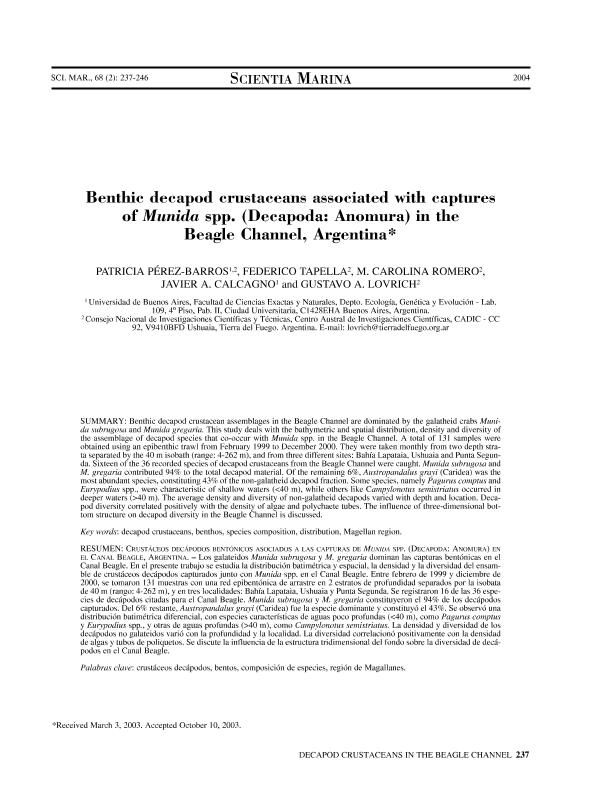Artículo
Los ensambles de crustáceos decápodos bentónicos en el Canal Beagle están dominados por los cangrejos galatheidos Munidasubrugosa y Munida gregaria . Este estudio trata sobre la distribución batimétrica y espacial, la densidad y la diversidad del conjunto de especies de decápodos que coexisten con Munida spp. en el Canal Beagle. Se obtuvieron un total de 131 muestras mediante un arrastre epibentónico desde febrero de 1999 hasta diciembre de 2000. Se tomaron mensualmente de dos estratos de profundidad separados por la isóbata de 40 m (rango: 4-262 m), y de tres sitios diferentes: Bahía Lapataia, Ushuaia y Punta Segunda. Se capturaron 16 de las 36 especies registradas de crustáceos decápodos del Canal Beagle. Munidasubrugosa y M. gregariacontribuyó con el 94% del material total de decápodos. Del 6% restante, Austropandalusgrayi (Caridea) fue la especie más abundante, constituyendo el 43% de la fracción decápodo no galatheid. Algunas especies, a saber, Paguruscomptus y Eurypodius spp., eran características de aguas poco profundas (<40 m), mientras que otras, como Campylonotus semistriatus, se encontraban en aguas más profundas (> 40 m). La densidad y diversidad promedio de los decápodos no galatheidos varió con la profundidad y la ubicación. La diversidad de decápodos se correlacionó positivamente con la densidad de algas y poliquetos tubulares. Se discute la influencia de la estructura tridimensional del fondo sobre la diversidad de decápodos en el Canal Beagle. Benthic decapod crustacean assemblages in the Beagle Channel are dominated by the galatheid crabs Munidasubrugosa and Munida gregaria. This study deals with the bathymetric and spatial distribution, density and diversity of the assemblage of decapod species that co-occur with Munida spp. in the Beagle Channel. A total of 131 samples were obtained using an epibenthic trawl from February 1999 to December 2000. They were taken monthly from two depth strata separated by the 40 m isobath (range: 4-262 m), and from three different sites: Bahía Lapataia, Ushuaia and Punta Segunda. Sixteen of the 36 recorded species of decapod crustaceans from the Beagle Channel were caught. Munidasubrugosa and M. gregaria contributed 94% to the total decapod material. Of the remaining 6%, Austropandalusgrayi (Caridea) was the most abundant species, constituting 43% of the non-galatheid decapod fraction. Some species, namely Paguruscomptus and Eurypodius spp., were characteristic of shallow waters (<40 m), while others like Campylonotus semistriatus occurred in deeper waters (> 40 m). The average density and diversity of non-galatheid decapods varied with depth and location. Decapod diversity correlated positively with the density of algae and polychaete tubes. The influence of three-dimensional bottom structure on decapod diversity in the Beagle Channel is discussed.
Benthic decapod crustaceans associated with captures of Munida spp. (Decapoda: Anomura) in the Beagle Channel, Argentina
Pérez Barros, Patricia ; Tapella, Federico
; Tapella, Federico ; Romero, Maria Carolina
; Romero, Maria Carolina ; Calagno, Javier A.; Lovrich, Gustavo Alejandro
; Calagno, Javier A.; Lovrich, Gustavo Alejandro
 ; Tapella, Federico
; Tapella, Federico ; Romero, Maria Carolina
; Romero, Maria Carolina ; Calagno, Javier A.; Lovrich, Gustavo Alejandro
; Calagno, Javier A.; Lovrich, Gustavo Alejandro
Fecha de publicación:
12/2004
Editorial:
Instituto de Ciencias del Mar Barcelona
Revista:
Scientia Marina
ISSN:
0214-8358
e-ISSN:
1886-8134
Idioma:
Inglés
Tipo de recurso:
Artículo publicado
Clasificación temática:
Resumen
Palabras clave:
decapod crustaceans
,
benthos
,
species composition
,
distribution
,
Magellan region
Archivos asociados
Licencia
Identificadores
Colecciones
Articulos(CADIC)
Articulos de CENTRO AUSTRAL DE INVESTIGACIONES CIENTIFICAS
Articulos de CENTRO AUSTRAL DE INVESTIGACIONES CIENTIFICAS
Articulos(SEDE CENTRAL)
Articulos de SEDE CENTRAL
Articulos de SEDE CENTRAL
Citación
Pérez Barros, Patricia; Tapella, Federico; Romero, Maria Carolina; Calagno, Javier A.; Lovrich, Gustavo Alejandro; Benthic decapod crustaceans associated with captures of Munida spp. (Decapoda: Anomura) in the Beagle Channel, Argentina; Instituto de Ciencias del Mar Barcelona; Scientia Marina; 68; 2; 12-2004; 237-246
Compartir
Altmétricas



